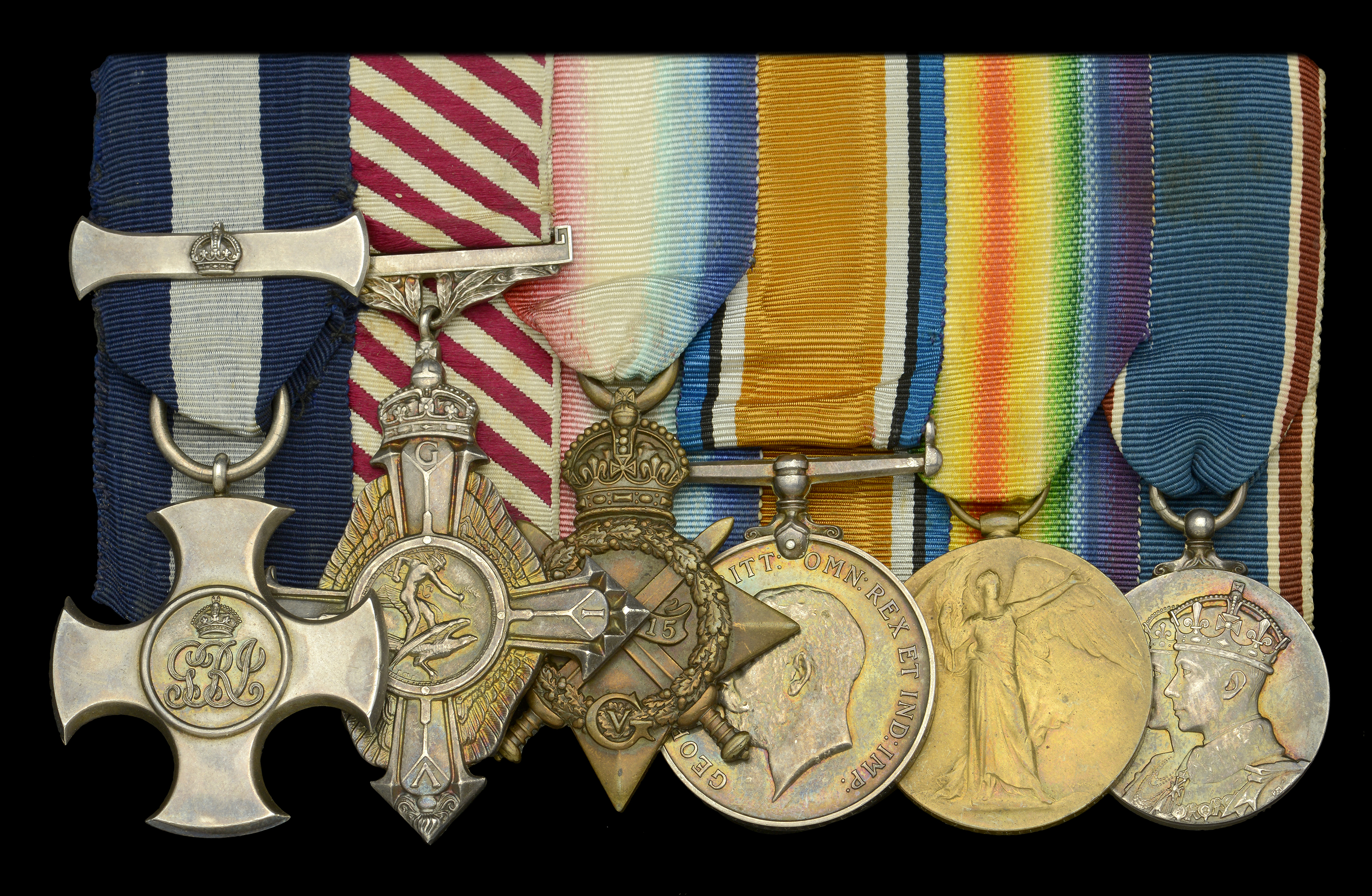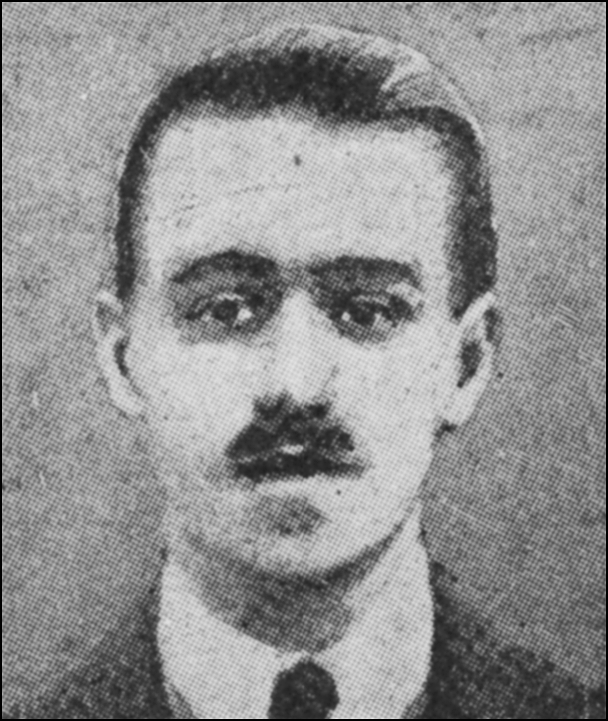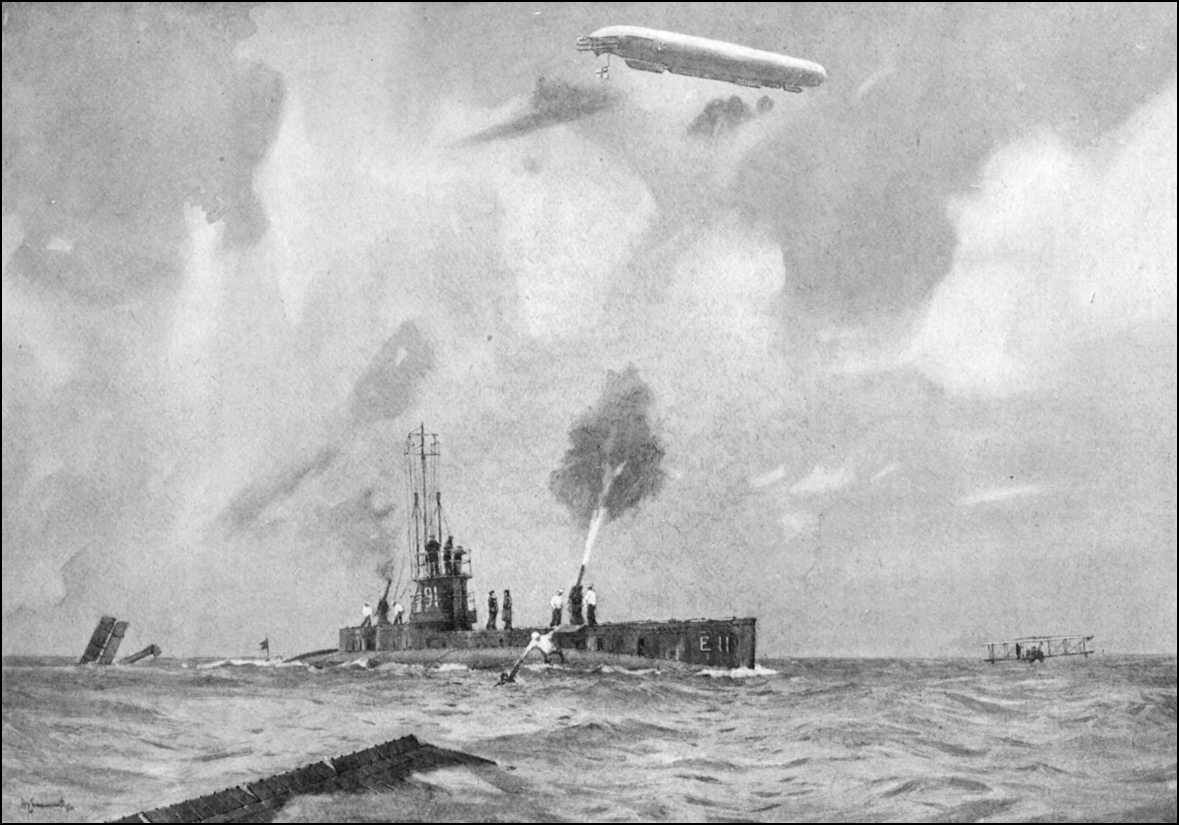The Great War D.S.C. and Bar, A.F.C. group of six awarded to Group Captain V. Gaskell-Blackburn, Royal Air Force, late Royal Naval Air Service, who, having participated in the first ever carrier-borne air strike in 1914, spotted for the Severn and Mersey against the Konigsberg in East Africa and was twice decorated for his gallant deeds in the Kut-el-Amara and Ctesiphon operations of 1915-16 Distinguished Service Cross, G.V.R., with Second Award Bar, hallmarked London 1915; Air Force Cross, G.V.R.; 1914-15 Star (Flt. Lieut. V. G. Blackburn, D.S.C. R.N.A.S.); British War and Victory Medals (Lt. Col. V. Gaskell-Blackburn, R.A.F.); Coronation 1937, mounted as worn, generally good very fine (6) £12,000-£16,000 --- Importation Duty This lot is subject to importation duty of 5% on the hammer price unless exported outside the UK --- --- Provenance: Dix Noonan Webb, December 2007. Vivian Gaskell-Blackburn was born in Leeds in 1892 and, shortly after leaving Uppingham, learnt to fly a Bristol biplane at Brooklands, taking his Pilot’s Certificate in September 1913 (No. 617). Commissioned in the Royal Naval Air Service on the outbreak of hostilities, he was quickly in action, piloting an Admiralty Type 74 “Folder” Seaplane in the famous Cuxhaven Raid on Christmas Day 1914, the world’s first carrier air strike. The operation, in essence an air reconnaissance of the Heligoland Bight, including Cuxhaven, was made by nine seaplanes, the pilots and their machines being conveyed to a point about 12 miles to the north of Heligoland before being lowered onto the water from the seaplane carriers Empress, Engadine and Riviera - the Arethusa and Undaunted, and eight destroyers, acted as escort. Seven of the seaplanes rose without any difficulty into the air, but the remaining two machines refused to become airborne with their heavy weight of bombs and had to be swung back on board their parent carriers. The former, with their pilots huddling deeper into their draughty cockpits in the clear, icy air, set course for Cuxhaven. Gaskell-Blackburn’s subsequent experiences, and those of his Observer, C.P.O. Mechanic J. W. Bell, are described in R. D. Layman’s definitive history, The Cuxhaven Raid: ‘After coming under fire from trawlers and destroyers, Gaskell-Blackburn ran into fog that ‘rendered navigation extremely difficult’, so much so that he was unable to tell where he crossed the coastline ... To the north-west he noted a number of destroyers steaming seaward and what appeared to be a British seaplane heading the same direction. Also to the north, Bell observed, were three battlecruisers and about 15 other vessels, all making heavy smoke ... The first three cruisers ‘opened an extremely hot anti-aircraft fire,’ as did the battlecruisers as the Short flew between the two groups of ships. The German fire was accurate for height, but the shells burst behind the planes. He reported, ‘I came then to the outskirts of Wilhelmshaven and was again subjected to an extremely hot anti-aircraft fire ... the most accurate and fiercest fire during the trip.’ A small-calibre shell or a large metal fragment from a heavier missile tore through a main float and damaged a starboard under-carriage strut, damage Bell could see by peering from his cockpit. Gaskell-Blackburn aimed two bombs at what he believed was the land battery responsible; it did not fire again, and my observer reported that he thought we did damage it’ ... With fuel running short, Gaskell-Blackburn decided not to take the return route via Wangeroog and the other Frisian islands, but headed west-north-west over the mainland. The fog closed in again during this inland flight, forcing him to keep to 700 feet. Every time the Short emerged into a momentarily clear patch of sky, he reported, it was fired at by anti-aircraft guns or rifles ... Gaskell-Blackburn reached the coast near Baltrum Island, Norderney’s neighbour to the east, emerging into clear sky, quickly recognising Norderney and heading north to seek the carriers ... ’ Layman next describes Gaskell-Blackburn’s ditching and rescue by the submarine E. 11, the latter already having picked up another pilot: ‘About ten minutes later E. 11’s lookouts spotted an airship to starboard - in fact the Zeppelin L5 commanded by Kapitanleutnant Klaus Hirsch - a complication compounded by the additional arrival of two more R.N.A.S. seaplanes, both dangerously short of fuel (No. 814 crewed by Gaskell-Blackburn and Bell, and No. 815 by Oliver and Bell). Both swept down and landed alongside the submarine, just as Nasmith spotted another looming danger in the form of a periscope (it was, in fact, the British submarine D. 6, hastening to the scene to offer assistance) ... Nasmith, tackling the problem of rescuing four airmen in the face of what appeared to be imminent underwater and aerial attack, acted with the cool-headed precision that would win him fame later in the war. Casting off the tow-line to [Miley’s] No. 120, he manoeuvred E. 11 so close to No. 815 that Oliver and Bell were able to step aboard her, then hailed Gaskell-Blackburn and Bell to swim to the submarine. Doffing their flying clothes and the impedimenta that Malone had insisted upon, they dived from their tilting plane and were hauled, dripping, aboard E. 11. Although the airship was now closing fast, Nasmith was obedient to the orders to destroy abandoned aircraft if possible. Since E. 11, like most British submarines in 1914, as yet lacked a deck gun, he ordered a machine-gun up from below and began to pepper the seaplanes’ floats with it. Oliver joined in with his pistol. Before this fire could have any effect, the aerial menace got too close for comfort, and Nasmith ordered a crash dive. With L5 nearly overhead, he waved his cap defiantly as he made for the conning tower hatch. It has often been claimed that the gesture confused the airshipmen into thinking E. 11 was a U-boat capturing enemy planes and caused them to delay dropping bombs. Gaskell-Blackburn thought so at the time. But there is nothing in German accounts to suggest the gesture was even seen, and Hirsch’s report makes it clear he was quite aware that the submarine was an enemy craft. He saw the rescue of the airmen clearly just before he sent two bombs crashing down. Their explosions shook both E. 11 and D. 6, although the former had time to dive to 40 feet before they went off and the latter was 60 feet down. The men on each submarine thought their boat was the target, but Hirsch’s account indicates he was aiming simply in the general vicinity of the seaplanes and the submerged E. 11, hoping any or all might be damaged. Observing no effect from the bombs, he headed seaward toward the Harwich Force. Nasmith meanwhile took E. 11 down to rest on the seabed, where at 20 fathoms the submariners shared their Christmas turkey and plum pudding with their five unusual guests.’ Gaskell-Blackburn was mentioned in despatches (London Gazette 19 February 1915 refers), and his Observer, C.P.O. Mechanic J. W. Bell, was awarded the D.S.M. In the operations against the Königsberg in East Africa in July 1915, while piloting a Henri Farman biplane out of Mafia Island, Gaskell-Blackburn was commended for his work in spotting the fall of shot from H.M’s monitors Severn and Mersey. And in the following month, on the 15th, he carried out a reconnaissance with Flight Commander Cull, D.S.O., this time in a newly delivered Cauldron G. III aircraft, in order to assess the damage caused the enemy cruiser; an excellent photograph of Gaskell-Blackburn at the helm of his Henri Farman, taken on Mafia Island in July 1915, is in the collection of the Fleet Air Ar...












